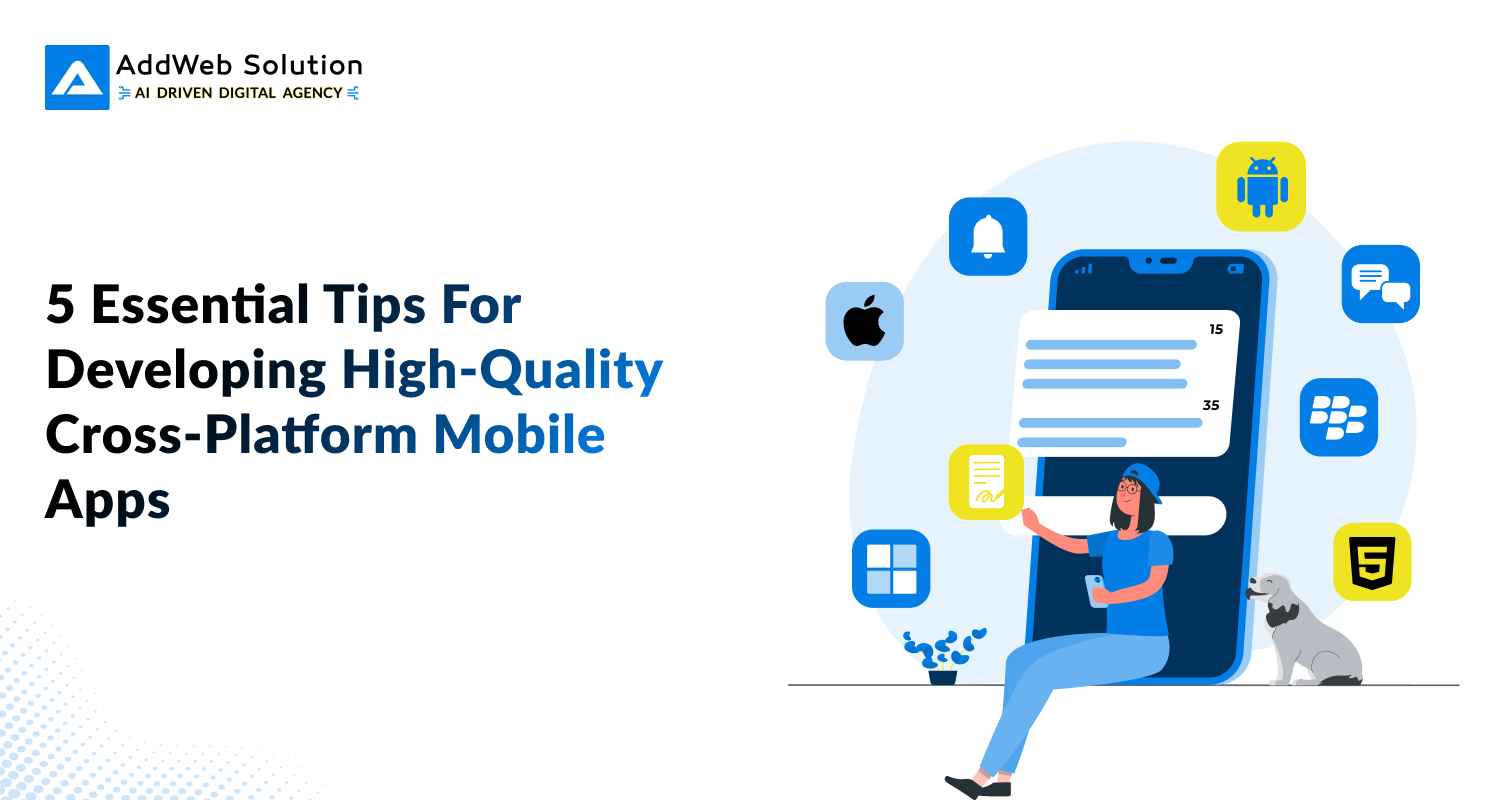Cross-platform mobile app development is the most popular way for business companies to achieve maximum reach with less development expense.
With the assistance of technology like React Native, Flutter, and Xamarin, apps can be created that switch smoothly between iOS and Android. However, proper planning, good development techniques, and a proper testing process are required to deliver high-quality cross-platform apps.
With an increasing demand for mobile applications, businesses must provide seamless, high-quality apps with a native-like user experience and the shortest time to market. When done well, precise cross-platform development can boost user interaction, conversions, and brand allegiance. However, it is dependent on every development phase.
In this blog, we will share five essential tips based on research and industry experience for creating high-quality cross-platform mobile applications. Whether you are an entrepreneur, a startup business owner, or an experienced developer, these tips will assist you in streamlining your development process and creating best-in-class applications.
Building Better Cross-Platform Apps: 5 Key Strategies
With the right strategies, you can create high-performance, secure, and user-friendly cross-platform apps. Follow these expert tips to optimize development, enhance UX, and ensure scalability.
1. Choose the Right Cross-Platform Framework
The right choice of framework is the starting point for deciding the performance, scalability, and efficiency of application development. The most commonly used are:
- Flutter: Offers a high-performance UI toolkit and fast UI rendering with Dart.
- React Native: Facebook-sponsored, allows reusing code through JavaScript.
- Xamarin: Microsoft-sponsored, offers C# coding.
According to Statista, Flutter and React Native dominate cross-platform development, with Flutter commanding 46% of developers’ affinity in 2023, closely followed by 32% belonging to React Native (Statista).
Why Framework Choice Matters:
A poorly chosen framework can lead to performance issues, longer development times, and higher maintenance costs. When choosing a framework, make sure to look at factors like community support, available add-ons, how well the framework can be integrated into current applications, and how specific the needs of your application are.
Key Considerations When Choosing a Framework:
- Performance: How is the framework performed in terms of animations, rendering, and data processing?
- Scalability: Can the framework handle more development and additional features?
- Community Support: A healthy developer community translates to improved troubleshooting and resources.
- Integration Capabilities: How simple is it for the framework to integrate with APIs, third-party libraries, and backend services?
Pro Tip:
Select a framework that best suits your app’s needs, as well as your target user base and developer skills. If speed and a graphics-intensive UI are your priorities, Flutter would be your top choice. Apps with heavy native functionality would suit React Native or Xamarin better.

2. Optimize App Performance
Performance is one of the most important issues when cross-platform development is utilized. A slow or unresponsive app can lead to extremely high bounce rates and bad reviews. The following are some methods of performance optimization:
Best Practices for Optimizing Performance:
- Use Native Modules: Supply native code for operations that are critical for performance, such as real-time calculations or animation.
- Minimize Dependencies: Too many third-party libraries can turn your app sluggish and offer extra security loopholes.
- Enable Code Splitting: Lowers app load time and improves user satisfaction.
- Use Lazy Loading: Load components when needed for improved efficiency.
- Optimize Images and Assets: Compress images and use vector graphics where applicable for quicker load times.
- Implement Efficient State Management: Using Redux or MobX can improve data management and reduce unnecessary re-renders.
Pro Tip:
Profile your app’s performance periodically using tools such as React Native or Flutter DevTools to detect and fix bottlenecks. Also, asynchronous operations and background processing should be utilized to prevent UI lag.
3. Prioritize UI/UX Consistency
Seamless user experience is essential to engagement and retention. Unifying UI on platforms provides the bonus benefits of increased usability and a unified brand identity.
How to Ensure UI/UX Consistency:
- Follow Platform-Specific Guidelines: Apple’s Human Interface Guidelines and Google’s Material Design are your bible.
- Use Adaptive Components: Get UI components to adapt based on screen size and device type.
- Test Across Multiple Devices: Emulators and real device testing can prevent UI inconsistencies.
- Consider Accessibility: Ensure your app is accessible for disabled users with voice commands, screen readers, and sufficient color contrast.
Why UI Consistency Matters:
Inconsistent UI/UX can annoy users, decrease interaction, and eventually lead to app abandonment. Consistency of the behavior of elements like buttons, navbars, and animations on all devices builds users’ trust and overall satisfaction.
Pro Tip:
Designers can utilize tools like Figma or Adobe XD to create platform-agnostic UI elements before coding. One may also include Dark Mode to support user preferences.

Build High-Quality Cross-Platform Mobile Apps

Pooja Upadhyay
Director Of People Operations & Client Relations
4. Implement Robust Testing Strategies
As cross-platform apps execute on different OS platforms, testing becomes a necessity to avoid functionality defects.
Testing Best Practices:
- Unit Testing: Ensures individual components are in good condition.
- Integration Testing: Ensures coordination among different app modules.
- UI Testing: Ensures the app interface is consistent.
- Beta Testing: Helps obtain real-time feedback before final release.
- Performance Testing: Discovers slow-to-load pages and inefficient code execution.
- Security Testing: Ensures data encryption and user authentication practices are enforced.
Pro Tip:
Test automation tools like Appium, Selenium, or Detox can be used to automate testing. Also, feedback from early adopters via reviews should be collected to refine the app further before releasing it officially.
5. Ensure Security and Data Protection
Security breaches can break user trust and business reputation. Secure your cross-platform app with these practices:
Security Best Practices:
- Implement End-to-End Encryption: Encrypt the transmission of sensitive data.
- Use Secure Authentication Methods: Utilize multi-factor authentication (MFA).
- Follow OWASP Mobile Security Guidelines: Prevent data leaks and injection attacks.
- Update Dependencies Regularly: Keep libraries and frameworks updated to patch security holes.
Pro Tip:
Conduct regular security audits and update your app’s security policies to stay one step ahead of the threats. Employ penetration testing tools like Burp Suite or ZAP to detect and remove vulnerabilities before they can be exploited.
Conclusion
Creating high-quality cross-platform mobile apps requires the inclusion of the right framework, performance optimization, UI/UX consistency, rigorous testing, and security best practices. By implementing these five key tips, you can create applications that offer a better user experience and stand out in the competitive market.
With research-driven strategies and cutting-edge tools, AddWeb Solution empowers businesses to build fast, scalable, and secure cross-platform apps. Partner with us to turn your app ideas into reality!

Turn Your App Idea into Reality

Pooja Upadhyay
Director Of People Operations & Client Relations


